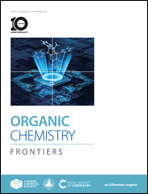Replication of synthetic recognition-encoded oligomers by ligation of trimer building blocks†
Abstract
The development of methods for replication of synthetic information oligomers will underpin the use of directed evolution to search new chemical space. Template-directed replication of triazole oligomers has been achieved using a covalent primer in conjunction with non-covalent binding of complementary building blocks. A phenol primer equipped with an alkyne was first attached to a benzoic recognition unit on a mixed sequence template via selective covalent ester base-pair formation. The remaining phenol recognition units on the template were then used for non-covalent binding of phosphine oxide oligomers equipped with an azide. The efficiency of the templated CuAAC reaction between the primer and phosphine oxide building blocks was investigated as a function of the number of H-bonds formed with the template. Increasing the strength of the non-covalent interaction between the template and the azide lead to a significant acceleration of the templated reaction. For shorter phosphine oxide oligomers intermolecular reactions compete with the templated process, but quantitative templated primer elongation was achieved with a phosphine oxide 3-mer building block that was able to form three H-bonds with the template. NMR spectroscopy and molecular models suggest that the template can fold, but addition of the phosphine oxide 3-mer leads to a complex with three H-bonds between phosphine oxide and phenol groups, aligning the azide and alkyne groups in a favourable geometry for the CuAAC reaction. In the product duplex, 1H and 31P NMR data confirm the presence of the three H-bonded base-pairs, demonstrating that the covalent and non-covalent base-pairs are geometrically compatible. A complete replication cycle was carried out starting from the oligotriazole template by covalent attachment of the primer, followed by template-directed elongation, and hydrolysis of the the ester base-pair in the resulting duplex to regenerate the template and liberate the copy strand. We have previously demonstrated sequence-selective oligomer replication using covalent base-pairing, but the trimer building block approach described here is suitable for replication of sequence information using non-covalent binding of the monomer building blocks to a template.



 Please wait while we load your content...
Please wait while we load your content...